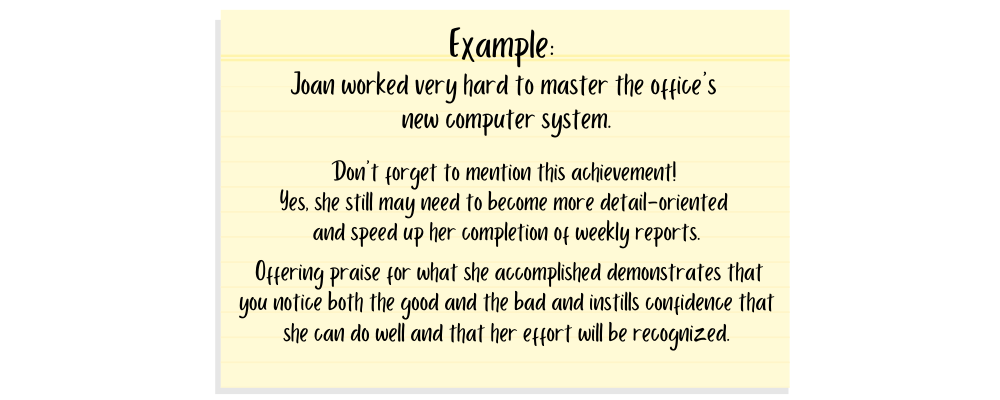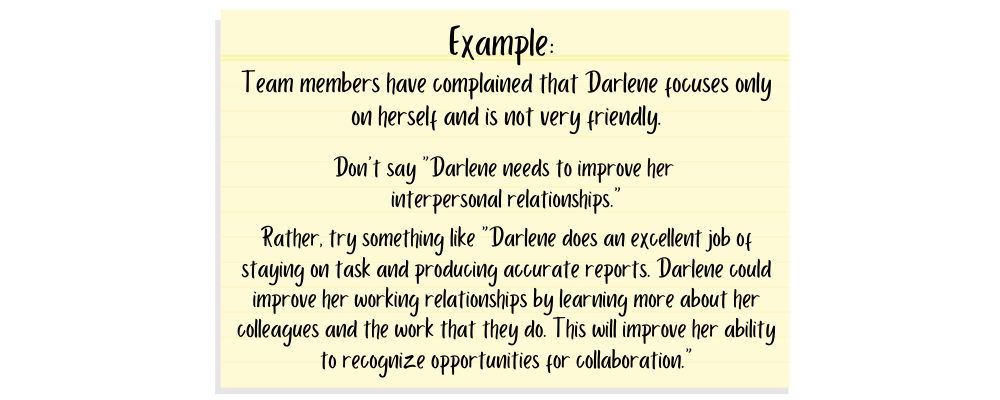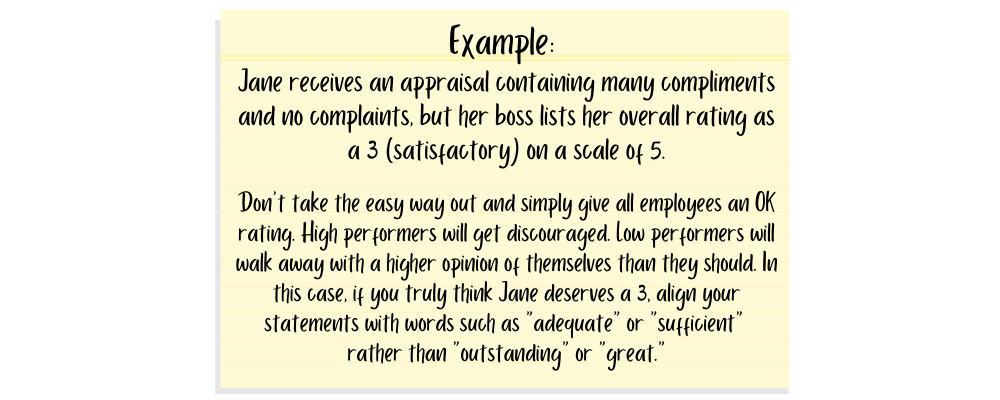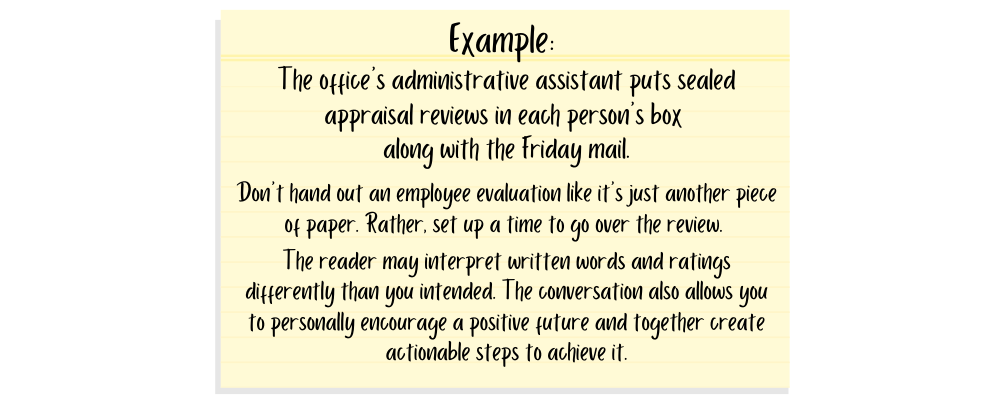7 tips for more effective written performance reviews
Why performance reviews matter (and how to write them)
Performance reviews generally do not rank high on a list of favorite activities. When done thoughtfully, however, they offer valuable information about where a worker currently stands and what actions could yield improvement in the future.
Even more challenging, however, is creating an effective written review. While a performance review conversation is valuable, a written record is needed for later reference.
When completing the document, consider the following seven things to give the reader of the review a clear, accurate account of his performance.
1. Base the appraisal on the entire evaluation period

A mid-year review should cover the past six months, not just the past six days. Throughout the appraisal timeframe, jot down regular notes about employee performance. Referring to these notes helps eliminate recency bias — the tendency to focus on the most current actions.
Likewise, you’ll avoid falling for the “Santa Claus trap.” This happens when employees are on their best behavior right before performance reviews, potentially skewing your perception.
For example, you’ll need to evaluate John’s team player ability.
Don’t immediately assume that he’s good in this area because you remember him helping out a colleague last week. To write an effective written review, look back at your notes. You may recall that last month, he took too much credit for landing a new account, which hurt the morale of his co-workers. That needs mentioning too.
2. Make corrective feedback easily visible
 Sensitive to how an employee will take criticism, a manager may try to deliver a message as “nicely” as possible. Sugarcoating with positive language, however, risks the problem never coming to the worker’s attention.
Sensitive to how an employee will take criticism, a manager may try to deliver a message as “nicely” as possible. Sugarcoating with positive language, however, risks the problem never coming to the worker’s attention.
Subsequently, you cannot expect the person to change his actions if not given clear notice that a problem exists and guidance on rectifying it.
Example: You’re unhappy that Mary rarely follows directions and insists on carrying things out her way.
Don’t try to spare her feelings by saying, “Mary takes a creative and innovative approach to performing her job.” This statement not only gives a positive impression but also fails to deliver the specific feedback she needs to improve.
Try something unemotional but direct: “The company has specific operating procedures vital to the overall good. Mary needs to follow these instructions. If she does not understand them or has suggestions for improvement, she should consult management.”
3. Stick to job-related comments
 A performance review evaluates how well someone meets the job expectations for which she was hired. An effective written review should stick to these points.
A performance review evaluates how well someone meets the job expectations for which she was hired. An effective written review should stick to these points.
It should not become a chance for a manager to play amateur psychologist or berate a worker’s personality traits. The receiver of this type of feedback may view you as invasive and overstepping your bounds.
Example: Tom shows up late regularly and often seems distracted. You’re betting that he’s depressed because of his recent divorce.
Don’t mention his personal life in the evaluation or recommend that he seek professional help. Rather, provide an honest rating with supporting justification for his job. “Tom was late seven times over the last five weeks. He also missed two important deadlines during this appraisal period.”
4. Give enough emphasis to good performance
 A manager certainly wants the worker being appraised to walk away knowing what to improve upon moving forward. However, leaders who spotlight problems while ignoring strengths run the risk of looking like they’re picking on someone.
A manager certainly wants the worker being appraised to walk away knowing what to improve upon moving forward. However, leaders who spotlight problems while ignoring strengths run the risk of looking like they’re picking on someone.
A deflated worker who deems his boss “impossible to please” has little motivation to institute the changes discussed. Besides the morale boost from receiving praise, people need to hear specifics about what they’re doing right to keep repeating those desirable actions.
Example: Joan worked very hard to master the office’s new computer system.
Don’t forget to mention this achievement! Yes, she still may need to become more detail-oriented and speed up her completion of weekly reports. You should draw attention to these.
However, offering praise for what she accomplished demonstrates that you notice both the good and the bad. It instills confidence that she can do well and that her effort will be recognized.
5. An effective written performance review doesn’t use fuzzy language
 Abstract words that do not pinpoint actions or behavior do little to help an employee understand what she does well or what she must improve upon. This is especially true in writing, where an employee may be unable to ask for clarification.
Abstract words that do not pinpoint actions or behavior do little to help an employee understand what she does well or what she must improve upon. This is especially true in writing, where an employee may be unable to ask for clarification.
What, for instance, constitutes a “bad attitude”? It could mean someone complains too much, doesn’t get along with colleagues, doesn’t pitch in to help others, is too critical of co-workers, or many other things.
To craft an effective written performance review, write your comments in ways that illustrate your thoughts clearly rather than leave them open to interpretation.
Example: Team members have complained that Darlene focuses only on herself and is not very friendly.
Don’t say, “Darlene needs to improve her interpersonal relationships.” Rather, try something like “Darlene does an excellent job of staying on task and producing accurate reports.
She consistently makes deadlines and achieves objectives. Darlene could improve her working relationships by learning more about her colleagues and their work.
This will improve her ability to recognize collaboration opportunities and help create a sense of teamwork.”
6. Make sure the words and ratings match
 Performance evaluations frequently consist of both statements and numbers. Together, they provide information that the individual worker can use to see how well he meets company expectations.
Performance evaluations frequently consist of both statements and numbers. Together, they provide information that the individual worker can use to see how well he meets company expectations.
Additionally, the organization can use this information when deciding things like raises and promotions. However, written feedback and scores that do not support each other confuse all readers.
Example: Jane receives an appraisal containing many compliments and no complaints, but her boss lists her overall rating as a 3 (satisfactory) on a scale of 5.
Don’t take the easy way out; give all employees an OK rating. High performers will get discouraged. Low performers will walk away with a higher opinion of themselves than they should.
In this case, if you truly think Jane deserves a 3, align your statements with words such as “adequate” or “sufficient” rather than “outstanding” or “great.”
7. A discussion should accompany an effective written review
 Lastly, for performance reviews to be worth their time, employees must treat them as more than “bureaucratic nonsense.” Given the right attitude and attention, they can serve as wonderful springboards for employees to examine their role honestly and learn how they can do it better.
Lastly, for performance reviews to be worth their time, employees must treat them as more than “bureaucratic nonsense.” Given the right attitude and attention, they can serve as wonderful springboards for employees to examine their role honestly and learn how they can do it better.
Example: The office’s administrative assistant puts sealed appraisal reviews in each person’s box along with the Friday mail.
Don’t hand out an employee evaluation like it’s just another piece of paper. Likewise, don’t distribute it in a manner that suggests you’re hoping people will just read them and leave you alone.
Rather, set up a time to go over the review. The reader may interpret written words and ratings differently than you intended. Talking together can prevent misunderstandings or hurt feelings. The conversation also allows you to personally encourage a positive future and create actionable steps to achieve it together.
Additional resources:
Performance reviews to empower employees and your business ![]()
Annual performance review template ![]()
AI job descriptions: How to write them faster and avoid bias ![]()






